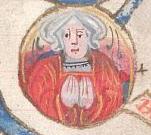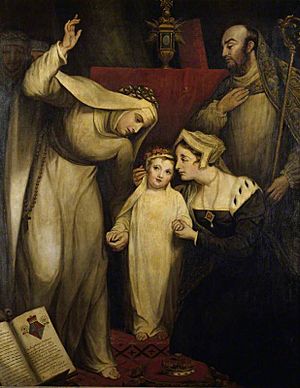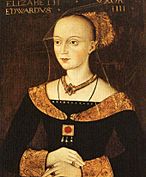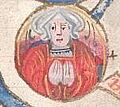Bridget of York facts for kids
Quick facts for kids Bridget of York |
|
|---|---|
 |
|
| Born | 10 November 1480 Eltham Palace, London, England |
| Died | bef. December 1507 (aged 26 or 27) Dartford Priory, Kent, England |
| House | York |
| Father | Edward IV of England |
| Mother | Elizabeth Woodville |
Bridget of York (born 10 November 1480 – died before December 1507) was an English princess. She was the seventh daughter of King Edward IV and his wife, Queen Elizabeth Woodville.
When Bridget was very young, her father died. Her uncle, Richard III, took the throne. He said that Bridget and her siblings were not legitimate children of the king. To keep them safe, Bridget's mother took them to Westminster Abbey. They stayed there for about a year. Later, Richard III promised not to harm the royal children. Bridget's older sisters went to live at court. Bridget and her sister Catherine likely stayed with their mother.
After Richard III died, Henry Tudor became the new king. He married Bridget's oldest sister, Elizabeth. The law that said Edward IV's children were not legitimate was cancelled. Bridget was thought of as a possible bride for a Scottish prince. However, she decided she wanted to become a nun. She moved to Dartford Priory in Kent. She only left once to attend her mother's funeral. As a nun, she stayed in touch with her sister, the Queen. The Queen often sent her money for her needs. Bridget died and was buried at Dartford Priory.
| Top - 0-9 A B C D E F G H I J K L M N O P Q R S T U V W X Y Z |
Bridget's Life
Her Birth
Bridget was born on 10 November 1480 at Eltham Palace. She was the youngest of ten children born to King Edward IV and Queen Elizabeth Woodville. Bridget had six older sisters. Only four of them lived to be adults: Elizabeth, Cecily, Anne, and Catherine.
She also had five brothers. Three were full brothers, and two were older half-brothers from her mother's first marriage. Her youngest full brother, George, died when he was about two years old. Her other two full brothers, Edward V and Richard, famously disappeared from the Tower of London in 1483. This happened during the rule of their uncle, Richard III.
Bridget was born on the day before St. Martin's Day. She was baptized the next day by Edward Story, the Bishop of Chichester. Her godmothers were her grandmother, Cecily Neville, Duchess of York, and her oldest sister, Elizabeth of York. Her godfather was William Waynflete, the Bishop of Winchester. Bridget was likely named after Bridget of Sweden, a famous saint. This name was new for the English royal family. Her grandmother, Cecily Neville, was very interested in the religious group founded by St. Bridget.
Her Childhood
On 9 April 1483, King Edward IV died suddenly. Bridget was not even three years old. This event caused big problems for her family. Bridget's older brother, Edward V, was supposed to become king. But his uncle, Richard, Duke of Gloucester, took control of him. Richard of Gloucester was also known as Lord Protector Richard III.
Bridget's uncle, Anthony Woodville, 2nd Earl Rivers, and her half-brother, Richard Grey, were arrested. They had been with the young king. Edward V was taken to the Tower of London. His younger brother, Richard, joined him there later. On the night of 29–30 April, Bridget's mother, Elizabeth Woodville, fled to Westminster Abbey. She took all her daughters and many valuable items with her. She asked for sanctuary there, meaning she was safe from arrest.
Some records suggest Bridget might have been too sick to go to the abbey. However, most information shows she was with her mother and sisters. They stayed in the sanctuary for many months.
On 22 June 1483, a law was passed saying that Edward IV's marriage to Elizabeth Woodville was not legal. This meant all their children, including Bridget, were declared illegitimate. They lost their right to the throne and all their royal titles. A few days later, Bridget's uncle and half-brother were executed. On 6 July 1483, Richard of Gloucester became King Richard III. Soon after, Bridget's brothers in the Tower of London were never seen again.
On Christmas Day 1483, Henry Tudor made a promise. He said he would marry Bridget's older sister, Elizabeth, if he became king. Henry Tudor's mother was working with Elizabeth Woodville against Richard III. However, a rebellion led by the Duke of Buckingham failed.
After this, Richard III decided to talk with Elizabeth Woodville. On 1 March 1484, the king promised publicly that his nieces would be safe. He said they would not be put in prison. He also promised they would live in "respectable places" and marry "men of noble birth." They would also receive money. The princesses were happy to leave the abbey and live under their uncle's care. Most people believe Bridget and her sisters went to the royal palace. But some say Bridget and her sister Catherine stayed with their mother. Bridget seemed to enjoy her time in the abbey.
Two years later, in August 1485, Richard III died in the Battle of Bosworth. Henry Tudor became the new king, Henry VII. He cancelled the law that had made Edward IV's children illegitimate. Bridget's oldest sister, Elizabeth, became Queen of England.
Becoming a Nun

Even when Bridget was very young, her parents thought about sending her to a monastery. There, she would live a religious life. Richard III had planned for her to marry one of his supporters. Later, Henry VII also made marriage plans for his wife's relatives. Bridget was considered as a possible bride for James, Duke of Rothesay, the Scottish heir. Her older sister Anne was also considered.
However, Bridget strongly wanted to become a nun. So, Anne was chosen as the possible bride for the Scottish Duke instead. Bridget was also briefly considered as a bride for Gian Galeazzo Sforza, Duke of Milan, in 1489. But this idea quickly ended for her.
We don't know the exact date Bridget went to Dartford Priory in Kent. But it was around 1489. She was under the care of Elizabeth Cressener, the prioress there. This happened before her mother died in 1492. Bridget's wish to enter a monastery was supported by Henry VII's mother, Lady Margaret Beaufort. Lady Margaret was very religious, and she likely influenced the king's final decision.
In 1492, Bridget was not yet twelve years old. She briefly left the monastery to attend her mother's funeral. Bridget joined other mourners. She went with her mother's body by water to Windsor. She attended a church service there. After that, she returned to Dartford Priory.
Dartford Priory was chosen for Bridget's religious life for a reason. It was founded by Edward III. It was also used by noble families from all over England for learning and religious life. The nuns at Dartford Priory lived a quiet, prayerful life. They spent their time in prayer and reading religious books. For example, in 1495, Bridget's grandmother, Cecily Neville, Duchess of York, left her three books in her will. Two were about the lives of holy women. The third was a popular book about saints' lives.
The monastery was closed to the outside world. Except for her mother's funeral, there is no proof that Bridget ever left Dartford Priory. Records about Bridget are very short and few. Thomas More, a famous writer, said Bridget lived a very virtuous life at Dartford.
Bridget kept in touch with her sister, Queen Elizabeth. The Queen paid for Bridget's small expenses and support. She sent her 20 marks each year. Sometimes, Bridget received extra payments from her sister. The last payment from the Queen to Bridget was a few months before Elizabeth's death in 1503. On 24 September 1502, Bridget received a letter from her sister. The Queen asked about Bridget's health and asked her to pray for her.
Death and Burial
Bridget died and was buried at Dartford Priory. We do not know what caused her death. The exact date of her death is also unknown. However, recent studies show that Bridget had died by December 1507.
Bridget was buried in the main part of the priory church. Her tombstone was likely destroyed or reused in 1541. This was during the English Reformation. Dartford Priory was mostly torn down and rebuilt. It became a royal house for her nephew, King Henry VIII. However, the house was not used for the next ten years.
Images for kids
-
Dedication of Bridget to the nunnery at Dartford, as imagined by James Northcote (1822).







